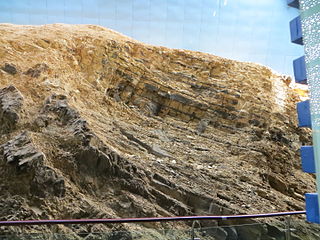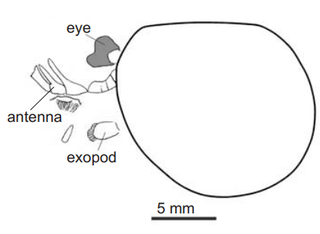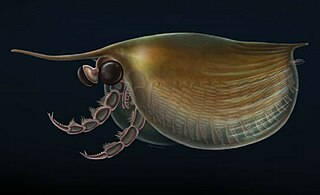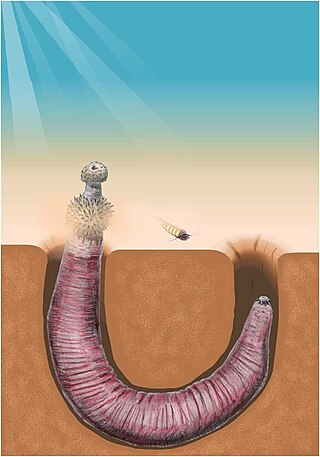
Hallucigenia is a genus of lobopodian known from Cambrian aged fossils in Burgess Shale-type deposits in Canada and China, and from isolated spines around the world. The generic name reflects the type species' unusual appearance and eccentric history of study; when it was erected as a genus, H. sparsa was reconstructed as an enigmatic animal upside down and back to front. Lobopodians are a grade of Paleozoic panarthropods from which the velvet worms, water bears, and arthropods arose.

The Maotianshan Shales (帽天山页岩) are a series of Early Cambrian sedimentary deposits in the Chiungchussu Formation, famous for their Konservat Lagerstätten, deposits known for the exceptional preservation of fossilized organisms or traces. The Maotianshan Shales form one of some forty Cambrian fossil locations worldwide exhibiting exquisite preservation of rarely preserved, non-mineralized soft tissue, comparable to the fossils of the Burgess Shale of British Columbia, Canada. They take their name from Maotianshan Hill in Chengjiang County, Yunnan Province, China.

Forfexicaris valida is a species of Lower Cambrian arthropod, the only species in the family Forfexicarididae. It is known from only two specimens from the Maotianshan shale Lagerstätte.

Parapeytoia is a genus of Cambrian arthropod. The type and only described species is Parapeytoia yunnanensis, lived over 518 million years ago in the Maotianshan shales of Yunnan, China. Unidentified fossils from the same genus also had been discovered from the nearby Wulongqing Formation.

Yunnanocephalus is a genus of ptychopariid trilobite. It lived during the late Atdabanian and Botomian stages, in what are currently Antarctica, Australia and China. It was a "moderately common" member of the Chengjiang Fauna. Yunnanocephalus is the only genus currently assigned to the Yunnanocephalidae family.
A number of assemblages bear fossil assemblages similar in character to that of the Burgess Shale. While many are also preserved in a similar fashion to the Burgess Shale, the term "Burgess Shale-type fauna" covers assemblages based on taxonomic criteria only.

Facivermis is a genus of sessile lobopodian from the Lower Cambrian Maotianshan shales of China

Chengjiang is a city located in Yuxi, Yunnan Province, China, just north of Fuxian Lake.

Isoxys is a genus of extinct bivalved Cambrian arthropod; the various species of which are thought to have been freely swimming predators. It had a pair of large spherical eyes, and two large frontal appendages used to grasp prey.

Occacaris is an extinct nektonic predatory arthropod from the Lower Cambrian Maotianshan shale Lagerstätte, known from three species. It bears a superficial resemblance to the Cambrian arthropod, Canadaspis, though, was much smaller, and had a pair of "great appendages", with which it may have grasped prey. It was originally considered to belong to Megacheira, however it is questioned in later study.

Pectocaris is an extinct genus of bivalved arthropods from the Cambrian Maotianshan Shales, Yunnan Province of China. There are currently four known species within the genus.

Archaeopriapulida is a group of priapulid worms known from Cambrian lagerstätte. The group is closely related to, and very similar to, the modern Priapulids. It is unclear whether it is mono- or polyphyletic. Despite a remarkable morphological similarity to their modern cousins, they fall outside of the priapulid crown group, which is not unambiguously represented in the fossil record until the Carboniferous. In addition to well-preserved body fossils, remains of several archaeopriapulid taxa are known to have been preserved primarily as organic microfossils, such as isolated scalids and pharyngeal teeth. They are probably closely related or paraphyletic to the palaeoscolecids; the relationship between these basal worms is somewhat unresolved.

The palaeoscolecids are a group of extinct ecdysozoan worms resembling armoured priapulids. They are known from the Lower Cambrian to the lower Ludfordian ; they are mainly found as disarticulated sclerites, but are also preserved in many of the Cambrian lagerstätten. They take their name from the typifying genus Palaeoscolex. Other genera include Cricocosmia from the Lower Cambrian Chengjiang biota. Their taxonomic affinities within Ecdysozoa have been the subject of debate.

Vetulicola cuneata is a species of extinct animal from the Early Cambrian Chengjiang biota of China. It was described by Hou Xian-guang in 1987 from the Lower Cambrian Chiungchussu Formation, and became the first animal under an eponymous phylum Vetulicolia.

Vetulicola rectangulata is a species of extinct animal from the Early Cambrian of the Chengjiang biota of China. Regarded as a deuterostome, it has characteristic rectangular anterior body on which the posterior tail region is attached. It was described by Luo Huilin and Hu Shi-xue in 1999.
Archotuba is a genus of elongated conical tubes that were seemingly deposited by colonial organisms. Known from the Chengjiang, its biological affinity is uncertain; it somewhat resembles the tubes of the 'priapulid' Selkirkia, but a cnidarian affinity is also possible. In the absence of soft parts, there is insufficient data to confirm a biological affiliation.
Luolishania is an extinct genus of lobopodian panarthropod and known from the Lower Cambrian Chiungchussu Formation of the Chengjiang County, Yunnan Province, China. A monotypic genus, it contains one species Luolishania longicruris. It was discovered and described by Hou Xian-Guang and Chen Jun-Yuan in 1989. It is one of the superarmoured Cambrian lobopodians suspected to be either an intermediate form in the origin of velvet worms (Onychophora) or basal to at least Tardigrada and Arthropoda. It is the basis of the family name Luolishaniidae, which also include other related lobopods such as Acinocricus, Collinsium, Facivermis, and Ovatiovermis. Along with Microdictyon, it is the first lobopodian fossil discovered from China.

Hallucigeniidae is a family of extinct worms belonging to the group Lobopodia that originated during the Cambrian explosion. It is based on the species Hallucigenia sparsa, the fossil of which was discovered by Charles Doolittle Walcott in 1911 from the Burgess Shale of British Columbia. The name Hallucigenia was created by Simon Conway Morris in 1977, from which the family was erected after discoveries of other hallucigeniid worms from other parts of the world. Classification of these lobopods and their relatives are still controversial, and the family consists of at least four genera.

Lenisambulatrix is a genus of extinct worm belonging to the group Lobopodia and known from the Lower Cambrian Maotianshan shale of China. It is represented by a single species L. humboldti. The incomplete fossil was discovered and described by Qiang Ou and Georg Mayer in 2018. Due to its missing parts, its relationship with other lobopodians is not clear. It shares many structural features with another Cambrian lobopodian Diania cactiformis, a fossil of which was found alongside it.
Hou Xian-guang is a Chinese paleontologist at Yunnan University who made key discoveries in the Cambrian life of China around 518 myr. His first discovery of animal fossils from the Cambrian sediments at Chengjiang County, Yunnan Province, led to the establishment of the Chengjiang biota, an assemblage of various life forms during the Cambrian Period. The discovery of the Chengjiang biota, remarked as "among the most spectacular in this [20th] century", added to the better understanding of how animal forms originated and evolved during the so-called Cambrian explosion.















